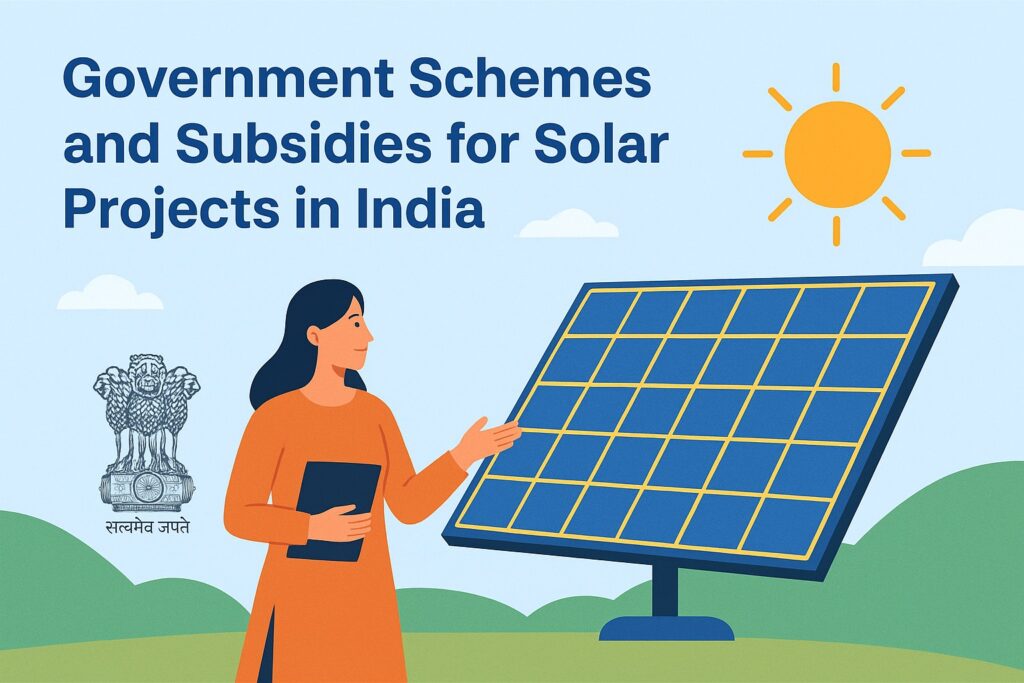The Indian government has launched a suite of ambitious solar programs and financial incentives to accelerate the country’s clean energy transition. Whether you’re a homeowner, a farmer, or a small business owner, now is one of the best times to invest in solar power. Here’s a closer look at the latest policies, how customers can apply, and why solar adoption is surging
Latest Solar Policies & Financial Benefits
PM Surya Ghar Muft Bijli Yojana
This flagship scheme, launched in 2024, aims to solarize up to 1 crore residential households across India. India Government+2ClearTax+2 Subsidies range from ₹30,000 per kW for a 1 kW rooftop system to ₹78,000 for 3 kW or larger systems. India Government+2Press Information Bureau+2
Key features:
- Central Financial Assistance (CFA) is credited directly into beneficiaries’ bank accounts. ClearTax+2Electronica Finance+2
- Households can receive up to 300 units of free electricity per month generated by the rooftop panels. ClearTax+2Wikipedia+2
- The scheme includes concessional financing options, making solar more accessible to low- and middle-income families. ClearTax+2Pulse Energy+2
Grid Connected Rooftop Solar Programme (Phase II)
Run by MNRE, this national program provides Central Financial Assistance to residential consumers installing grid-connected rooftop solar (GCRTS). Ministry of New and Renewable Energy+2Ministry of New and Renewable Energy+2
- Homeowners can apply either directly via the MNRE-approved channel or through their electricity distribution company (DISCOM). Tata Power+3Ministry of New and Renewable Energy+3Electronica Finance+3
- DISCOMs may also get incentives for commissioning rooftop solar and implementing net-metering arrangements. Ministry of New and Renewable Energy+2Ministry of New and Renewable Energy+2
PM KUSUM Scheme (Pradhan Mantri Kisan Urja Suraksha Evam Utthan Mahabhiyan)
Launched in 2019, this programme is aimed at farmers and rural solar deployment. Wikipedia+1
It consists of three main components:
- Ground-mounted grid-connected solar plants
- Stand-alone solar pumps for irrigation
- Solarisation of agricultural feeders
Farmers installing solar irrigation pumps can receive up to 60% subsidy on total costs, plus soft loans or additional state incentives. Wikipedia+2Tata Power+2
State-Level Top-ups and Incentives
Many state governments offer additional subsidies or financial support to boost rooftop solar adoption. For example, Gujarat provides extra subsidies of ₹10,000–₹20,000 over the central government subsidy. Rayzon Solar+1
Other states and local DISCOMs may offer simplified net-metering procedures, faster approval timelines, or preferential financing.
How Customers Can Apply
Here’s a step-by-step guide for homeowners, farmers, and businesses keen to take advantage of solar subsidies:
Step 1: Check eligibility and register
- Visit the official PM Surya Ghar national portal or MNRE Services portal to register. India Government+2India Services+2
- Enter consumer details: electricity connection number, address, ID, roof ownership proof, etc. The portal may auto-fetch useful data like electricity bills or rooftop feasibility estimates. Electronica Finance+3ClearTax+3India Services+3
Step 2: Choose an approved vendor
- Select an MNRE-approved solar installer or vendor. The portal typically lists approved vendors or partner installers. Electronica Finance+2India Services+2
- The vendor conducts a site survey, assesses rooftop/ground space, and recommends system sizing and equipment.
Step 3: Proposal submission & financing
- Once you finalize the system design and vendor, the installer helps submit the proposal via the online portal or DISCOM channel. Tata Power+3Ministry of New and Renewable Energy+3India Services+3
- Apply for subsidy (Central Financial Assistance) and, if eligible, concessional financing or loans. Some state-level incentives can be applied at this stage too.
Step 4: Installation, commissioning, and inspection
- The approved vendor installs the solar system according to MNRE guidelines. India Services+2Electronica Finance+2
- After commissioning, the vendor or homeowner uploads required documentation and photos to the portal: commissioning certificate, invoice, net-metering approval, system photos, etc. Electronica Finance+2India Services+2
- A final physical inspection may be conducted by the DISCOM or state implementation agency. Once approved, the subsidy amount is credited directly into the bank account. Electronica Finance+2Ministry of New and Renewable Energy+2
Step 5: Begin generating solar power
- With net metering enabled, homeowners can offset their electricity bills, sell surplus power back to the grid, and enjoy long-term savings and energy independence.
- Farmers using solar pumps or standalone systems under KUSUM can save fuel costs, access reliable irrigation, and potentially sell surplus solar electricity.
Why Now Is the Best Time to Go Solar
Several converging trends make 2025–2026 an optimal window to adopt solar power in India:
📉 Solar technology costs are falling
The price of solar panels, inverters, and batteries has dropped significantly over the past decade, improving return on investment.
🏛️ Strong and growing government support
Big central schemes like PM Surya Ghar and PM KUSUM are being expanded, and state governments are offering extra incentives, faster approvals, and better financing. Wikipedia+3Pulse Energy+3Rayzon Solar+3
🌞 Energy security and independence
Solar systems reduce dependence on the grid and fossil fuels. In rural areas or grid-unstable zones, solar + battery or solar pumps provide a reliable alternative.
💸 Financial savings and new income streams
With subsidies, concessional loans, and net-metering or power-sales options, solar projects can yield a strong financial return — sometimes paying for themselves in just a few years.
🌱 Environmental and social benefits
Going solar helps reduce carbon emissions, supports the clean energy transition, and improves local livelihoods (especially in agriculture). Solar adoption also aligns with India’s National Solar Mission and climate goals. Wikipedia+2Press Information Bureau+2
⏳ Limited-time incentives
Some subsidies and financial assistance packages come with deadlines or installation targets. Delaying might mean missing out on the best financial deals. Ministry of New and Renewable Energy+2Press Information BurConclusion
Conclusion
If you’ve been considering switching to solar, 2025 is a golden opportunity. Indian government schemes offer strong incentives, simplified application processes, and the promise of long-term financial and environmental returns.
Whether you’re installing rooftop solar for your home, solar pumps for agriculture, or a hybrid solar project for your business, the combination of falling solar technology costs and robust policy support makes this a smart time to go solar.

